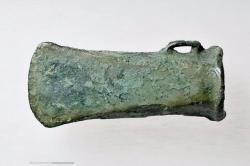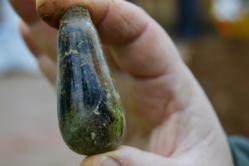INSTITUT SUPERIEUR D'ANTHROPOLOGIE
INSTITUTE OF ANTHROPOLOGY
ONLINE COURSES / COURS A DISTANCE
SPRING TERM : APRIL 2016
REGISTER NOW
SUISSE –  Cugy - Découverte très rare à Cugy (FR). Un prospecteur amateur doté d’une autorisation du service archéologique est tombé sur une hache en bronze parfaitement conservée sur la colline de l’Aléri. Datée de 950-800 av. J.-C., durant l’âge du Bronze final, cette hache à douille a bénéficié d’une première étude dans le dernier Cahier d’Archéologie fribourgeois. Sur tout ce canton, seules cinq haches de ce type étaient jusqu’ici connues. Ce qui réjouit particulièrement les archéologues, c’est la typologie de l’objet. «Elle a été probablement fondue en Normandie ou en Bretagne avant d’arriver jusqu’ici», détaille l’archéologue Michel Mauvilly, auteur de l’étude. S’il s’agissait à l’époque d’objets produits en grand nombre sur la façade Atlantique – on parle de dizaines de milliers d’exemplaires de qualité variable – ce type de hache est toutefois «fort peu» représenté dans les collections suisses. La découverte provient d’une colline probablement fortifiée à la même époque, quand les habitants des stations lacustres concentraient le pouvoir politique et économique sur les hauteurs. Développées à la protohistoire, les lames de ces haches étaient creuses afin d’être fixées à un manche en bois. Leur utilisation utilitaire, religieuse, symbolique ou monétaire est fréquemment interrogée par les spécialistes.
Cugy - Découverte très rare à Cugy (FR). Un prospecteur amateur doté d’une autorisation du service archéologique est tombé sur une hache en bronze parfaitement conservée sur la colline de l’Aléri. Datée de 950-800 av. J.-C., durant l’âge du Bronze final, cette hache à douille a bénéficié d’une première étude dans le dernier Cahier d’Archéologie fribourgeois. Sur tout ce canton, seules cinq haches de ce type étaient jusqu’ici connues. Ce qui réjouit particulièrement les archéologues, c’est la typologie de l’objet. «Elle a été probablement fondue en Normandie ou en Bretagne avant d’arriver jusqu’ici», détaille l’archéologue Michel Mauvilly, auteur de l’étude. S’il s’agissait à l’époque d’objets produits en grand nombre sur la façade Atlantique – on parle de dizaines de milliers d’exemplaires de qualité variable – ce type de hache est toutefois «fort peu» représenté dans les collections suisses. La découverte provient d’une colline probablement fortifiée à la même époque, quand les habitants des stations lacustres concentraient le pouvoir politique et économique sur les hauteurs. Développées à la protohistoire, les lames de ces haches étaient creuses afin d’être fixées à un manche en bois. Leur utilisation utilitaire, religieuse, symbolique ou monétaire est fréquemment interrogée par les spécialistes.
http://www.tdg.ch/suisse/suisse-romanderare-hache-ge-bronze-trouvee-cugy/story/27078551
ROYAUME UNI –  Delapre Abbey - Roman artefacts have been discovered at the site of Delapre Abbey in Northampton. Iain Soden, of Iain Soden Heritage Services, the on-site archaeologist discovered a concentration of high-quality pottery, a glass vessel, and a copper alloy pin, all most likely from the late Roman period. Previously it was thought the medieval abbey, built in the twelfth century, was the earliest activity on the site. One of the most interesting and intriguing finds was a small glass phial which appears intact, and will be the subject of further study, along with the other relics. The work is expected to be complete this summer.
Delapre Abbey - Roman artefacts have been discovered at the site of Delapre Abbey in Northampton. Iain Soden, of Iain Soden Heritage Services, the on-site archaeologist discovered a concentration of high-quality pottery, a glass vessel, and a copper alloy pin, all most likely from the late Roman period. Previously it was thought the medieval abbey, built in the twelfth century, was the earliest activity on the site. One of the most interesting and intriguing finds was a small glass phial which appears intact, and will be the subject of further study, along with the other relics. The work is expected to be complete this summer.
http://www.northamptonchron.co.uk/news/local/roman-artefacts-found-on-delapre-abbey-site-in-northampton-1-7154301?
INDE –  Utkottai Maligaimedu - The State Archaeology Department has taken up a programme for strengthening the conservation of the excavation site at Utkottai Maligaimedu village, popularly known as Maligaimedu among the local residents, about six km from Gangaikondacholapuram, where the famour Chola ruler Rajendra Chola I had constructed his palace. The State Archaeology Department has undertaken the excavation in a phased manner for the past three decades and is also focussing on conservation of the palace which is now represented by a layer of brick structures. A massive temple dedicated to Sri Brahadeeswarar was built by Rajendra Chola I at Gangaikondacholapuram on the lines of his father Raja Raja Chola’s Big Temple in Thanjavur. Gangaikondacholapuram had remained the capital of Chola dynasty for about 250 years. The excavation also unearthed a wide range of antiquities, throwing light on the link between the Chola dynasty and South-East Asia during the period from the 10th century to 13th century. Coarse and red ware shreds; decorated knobs; decorated pot shreds, lid portion; Chola tiles and Chinese Celedon ware and porcelain ware shreds have been collected. The thickness and height of the fortified wall measured 2.15 m and 1.35 m respectively. The exposed palace remains accounted for an area of 7 m by 3.5 m.
Utkottai Maligaimedu - The State Archaeology Department has taken up a programme for strengthening the conservation of the excavation site at Utkottai Maligaimedu village, popularly known as Maligaimedu among the local residents, about six km from Gangaikondacholapuram, where the famour Chola ruler Rajendra Chola I had constructed his palace. The State Archaeology Department has undertaken the excavation in a phased manner for the past three decades and is also focussing on conservation of the palace which is now represented by a layer of brick structures. A massive temple dedicated to Sri Brahadeeswarar was built by Rajendra Chola I at Gangaikondacholapuram on the lines of his father Raja Raja Chola’s Big Temple in Thanjavur. Gangaikondacholapuram had remained the capital of Chola dynasty for about 250 years. The excavation also unearthed a wide range of antiquities, throwing light on the link between the Chola dynasty and South-East Asia during the period from the 10th century to 13th century. Coarse and red ware shreds; decorated knobs; decorated pot shreds, lid portion; Chola tiles and Chinese Celedon ware and porcelain ware shreds have been collected. The thickness and height of the fortified wall measured 2.15 m and 1.35 m respectively. The exposed palace remains accounted for an area of 7 m by 3.5 m.
http://www.thehindu.com/news/cities/Tiruchirapalli/chola-palace-excavation-site-at-maligaimedu-strengthened/article8090831.ece
CHINE –  Nanhai No 1 - More than 14,000 objects have so far been salvaged from Nanhai No 1, the ancient Chinese cargo ship which sank in the South China Sea about 800 years ago. The relics contain hoards of gold, silver, copper and ceramic artefacts, archaeologists said. Most recent excavations at the shipwreck have yielded tens of thousands of copper coins and porcelain objects such as pots, bottles, bowls and plates, the Xinhua news agency reported. The artefacts were found in a well-preserved state.According to archaeologists, the 30-metre wooden vessel, discovered in 1987, contain around 60,000 to 80,000 precious artefacts, including gold, silver and porcelain trading goods. Built between 1127 and 1279AD during the reign of the Song Dynasty, the ship is believed to have sunk due to stormy waves.
Nanhai No 1 - More than 14,000 objects have so far been salvaged from Nanhai No 1, the ancient Chinese cargo ship which sank in the South China Sea about 800 years ago. The relics contain hoards of gold, silver, copper and ceramic artefacts, archaeologists said. Most recent excavations at the shipwreck have yielded tens of thousands of copper coins and porcelain objects such as pots, bottles, bowls and plates, the Xinhua news agency reported. The artefacts were found in a well-preserved state.According to archaeologists, the 30-metre wooden vessel, discovered in 1987, contain around 60,000 to 80,000 precious artefacts, including gold, silver and porcelain trading goods. Built between 1127 and 1279AD during the reign of the Song Dynasty, the ship is believed to have sunk due to stormy waves.
https://uk.news.yahoo.com/china-14-000-gold-silver-115748757.html
IRAN –  Teheran - Preliminary investigations in Tehran’s Kavousiyeh hills has indicated that the hills had been settled in Sialk 1, Sialk 3, Bronze and Iron ages. Maryam Molaei, the head of a team of archeologists working on Kavousiyeh hills said that the evidence was few but still highly suggestive that the settlement in the hill had been continuous; “Kavousiyeh hills site has been added to the list of prehistoric sites with settlement during a research investigating land downdraft in Tehran; since then, no serious archeological investigation addressed the hills, effectively putting to abeyance valuable information imbedded in the hills strata. “Our findings suggested that the hills are more than two acres in area and its main site falls today into the Garden of Shazdeh; urban development has covered parts of the hills. Attempts to plant trees and making changes to skirts of the hill has negatively changed the archeological profile on the place,” said the head of the archeology team, adding that systematic investigation and setting an exact figure of the hill area had been but impossible. “In investigation of Kavousiyeh hills, modern cutting-edge technology of drone-aided imaging robot has been used; aerial photogrammetry helped also preparation of a highly precise topographic map of the hills; we currently hope to see further investigation which would address the exact area of the settled hill during prehistory and draft a set of regulations to preserve the delimitation of the hill,” she emphasized. “The archeology team will have stratigraphic excavations to set the settlement sequence from beginning to the end of the settlement,” Molaei added.
Teheran - Preliminary investigations in Tehran’s Kavousiyeh hills has indicated that the hills had been settled in Sialk 1, Sialk 3, Bronze and Iron ages. Maryam Molaei, the head of a team of archeologists working on Kavousiyeh hills said that the evidence was few but still highly suggestive that the settlement in the hill had been continuous; “Kavousiyeh hills site has been added to the list of prehistoric sites with settlement during a research investigating land downdraft in Tehran; since then, no serious archeological investigation addressed the hills, effectively putting to abeyance valuable information imbedded in the hills strata. “Our findings suggested that the hills are more than two acres in area and its main site falls today into the Garden of Shazdeh; urban development has covered parts of the hills. Attempts to plant trees and making changes to skirts of the hill has negatively changed the archeological profile on the place,” said the head of the archeology team, adding that systematic investigation and setting an exact figure of the hill area had been but impossible. “In investigation of Kavousiyeh hills, modern cutting-edge technology of drone-aided imaging robot has been used; aerial photogrammetry helped also preparation of a highly precise topographic map of the hills; we currently hope to see further investigation which would address the exact area of the settled hill during prehistory and draft a set of regulations to preserve the delimitation of the hill,” she emphasized. “The archeology team will have stratigraphic excavations to set the settlement sequence from beginning to the end of the settlement,” Molaei added.
http://en.mehrnews.com/news/113493/Bronze-Iron-Age-items-found-in-Tehran-s-Kavousiyeh-hills?